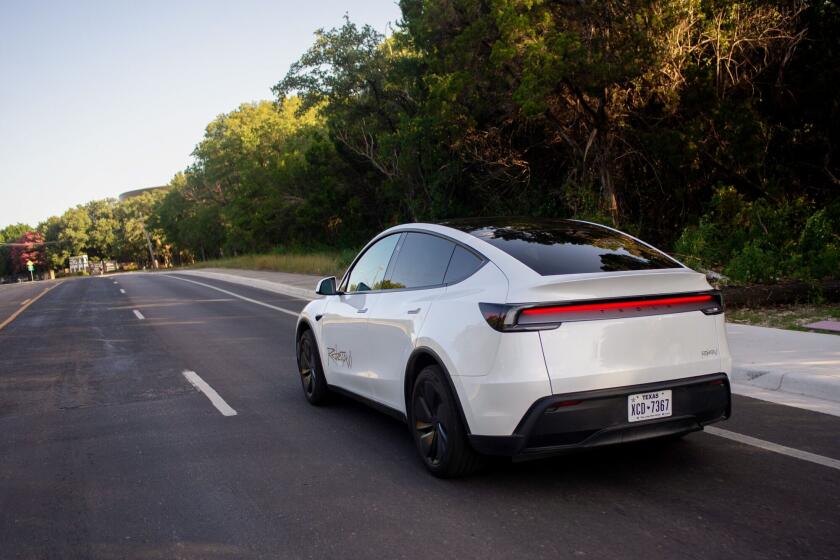Little Chance Caltrans Will Pay for Broken Windshield
- Share via
Dear Street Smart:
On Interstate 15 in San Bernardino County, one mile south of Baseline Exit at 9:40 a.m. on a recent Saturday, my car was struck by flying debris (a two-by-six) and it broke the windshield. The material had been hit by a vehicle in front and there was no way to avoid being hit. With a $500 comprehensive deductible, it becomes an expensive proposition. We have witnesses in the vehicle in front of mine and the one following. Is there an opportunity to recover the deductible from the county or Caltrans since the materials were on the roadway and caused a man-made hazardous condition?
Barry Allen
Huntington Beach
*
Not very likely, according to Sam Eagle, a Fountain Valley attorney specializing in traffic and personal injury cases and a judge pro tem in the Traffic Division of Municipal Court in Westminster.
The problem, Eagle said, is that as in a claim arising from personal injury on private property, you would have to prove that a dangerous condition existed on the property and that the property owner--in this case Caltrans--had notice or knowledge of that condition.
In other words, did a Caltrans worker notice the debris the day before and do nothing about it? Or did the agency fail to respond to a report of the debris by another driver?
In either case, Eagle said, the state could be liable.
If, on the other hand, the two-by-six fell off a truck shortly before you hit it, then Caltrans is not liable.
In either case, you have no proof.
If you must pursue the case, Eagle said, do it in Small Claims Court on the off chance that Caltrans will decide to surrender the money instead of releasing an employee from other duties long enough to represent its interests.
Eagle’s advice: “Just pay the deductible. Because of the legal and economic considerations, it would not be feasible to make a claim against Caltrans.”
*
Dear Street Smart:
Recently I have noticed that the railroad traffic along the Santa Ana Canyon has increased enormously in terms of train length and frequency. That doesn’t bother me much. However, the long and loud horns blown near the Imperial Highway crossing have been a real nuisance to our populous vicinity.
From my observation, this seems to be the only spot where the horns are blown within the Orange County limits.
As far as my memory goes, there has never been an accident at this location. Could the Atchison, Topeka & Santa Fe railroad be more considerate of this otherwise quiet neighborhood? If the horn blow cannot be avoided at all, can the number of the horn blows, which sometimes are as many as five, be minimized to one or two for each crossing?
K.C. Chang
Anaheim
*
The number of times a train blows its horn at a crossing is determined by state and federal regulations.
They require an approaching train to sound its horn at least four times, two long blasts and a short blast followed by another long blast, within a quarter-mile of a crossing, said Mike Martin, a spokesman for the Atchison, Topeka & Santa Fe Railway Co. in Fort Worth, Texas.
This is particularly important at the crossing you mention, Martin said, because of the heavy street traffic and because as many as 40 trains pass that way each day.
“This is our primary line,” he said. “It’s the main line for the Santa Fe Railway into and out of Southern California.”
Don’t despair, though; help may be on the way. A special task force including representatives from Caltrans and the railroad have been meeting for about six months to discuss building an overpass or underpass at the Imperial Highway crossing. Once that’s accomplished, Martin said, the horn-blowing requirement won’t apply.
*
Last week’s column urging joggers to stay out of the way of bicyclists prompted one Huntington Beach jogger to issue a call for understanding between the two groups.
“I’ve been running in the streets . . . for many years,” Molly Bagnoli wrote. “I always use the bike lane for my run, and when a bike approaches, I move to the side of the lane closest to the cars, as I am running against the traffic and can see if a car is coming. This small maneuver allows plenty of room for both the biker and me. All the bikers in my neighborhood are courteous and generous in sharing the lane.”
She concludes: “Common courtesy between users is all it takes to share the bike lane. [Let’s] get some understanding and acceptance between the groups. We’re all out there to enjoy Mother Nature!”
Street Smart appears Mondays in The Times Orange County Edition. Readers are invited to submit comments and questions about traffic, commuting and what makes it difficult to get around in Orange County. Include simple sketches if helpful. Letters may be published in upcoming columns. Please write to David Haldane, c/o Street Smart, The Times Orange County, P.O. Box 2008, Costa Mesa, CA 92626, send faxes to (714) 966-7711 or e-mail him at David.Haldane@latimes.com. Include your full name, address and day and evening phone numbers. Letters may be edited, and no anonymous letters will be accepted.
More to Read
Sign up for Essential California
The most important California stories and recommendations in your inbox every morning.
You may occasionally receive promotional content from the Los Angeles Times.













